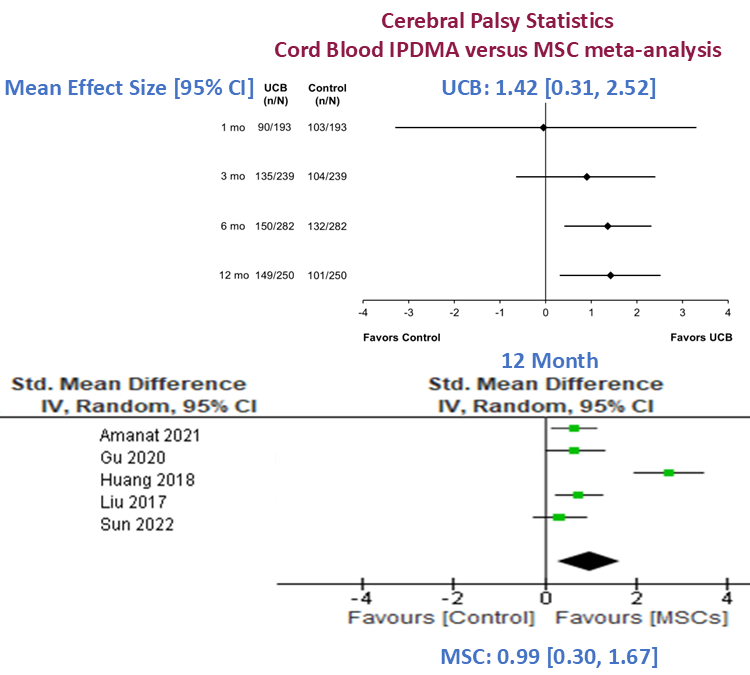You are here
Cord Blood Banking Starts to Live Up to its Promise
 Since 2005, cells from cord blood or umbilical cord tissue have been tested in numerous studies for newborn brain injuries and neurodevelopmental disorders1. Many parents have been sold on contracts with cord blood banks to store this blood and tissue based on the promise from those studies. But the journey from clinical trials to therapies that are widely available has been very slow and frustrating. There has been some pushback from consumers that cord blood banking is not living up to its promise2.
Since 2005, cells from cord blood or umbilical cord tissue have been tested in numerous studies for newborn brain injuries and neurodevelopmental disorders1. Many parents have been sold on contracts with cord blood banks to store this blood and tissue based on the promise from those studies. But the journey from clinical trials to therapies that are widely available has been very slow and frustrating. There has been some pushback from consumers that cord blood banking is not living up to its promise2.
The pediatric developmental disorders that have been studied with cells from cord blood or cord tissue have very variable symptoms. The clinical trials of cell therapy for these disorders have not followed a standardized pattern for describing the patients or delivering the therapy. This makes it very difficult to compare the outcomes of studies. Also, these studies often have a cross-over design, where children in the control group also receive the treatment, after a time delay. There are many challenges facing this area of research. For example, a study may fail to show a difference between the treatment and control groups if the time delay between their treatments is too short3. A study may fail to meet its designated endpoints if only a subset of the participants had clear benefit from the cell therapy4,5. The quest to obtain funding for this research introduces additional delays6.
In spring of 2025, two important papers were published which demonstrated the efficacy of cell therapies for cerebral palsy. The two publications are both statistical analyses of previous studies, called meta-analyses. These results are a big boost for the whole field of perinatal cell therapy for a couple of reasons. Primarily, because there is finally conclusive evidence that a cell therapy can provide benefit for a pediatric neurodevelopmental disorder. And moreover, because both studies looked at the diagnosis of cerebral palsy, which is the most common motor disability in childhood7. This proof of efficacy is not for a rare disease; it is for a disorder that afflicts between 10% and 15% of babies that are born prematurely8.
In April 2025, a paper was published in the journal Pediatrics which conclusively proved (not just suggested) that cord blood cell therapy has a large treatment benefit for the motor skills of children with cerebral palsy9,10.
A month later, in May 2025 another paper was published in Cells which showed that therapy with mesenchymal stromal cells (MSC) from multiple sources, but mostly cord tissue, also benefits the motor skills of children with cerebral palsy11.
Disclaimer: It is imprecise to directly compare the two recent statistical reviews because they have different methodologies. Nonetheless, many people in the cord blood banking community want to see a bulleted summary of the key points in the two papers, as follows.
- The cord blood statistics paper is an Individual Participant Data Meta-Analysis (IPDMA). This means that it reanalyzes data from previous studies at the level of each participant. The MSC statistics paper is a standard meta-analysis which uses the overall outcomes from the previous studies. Hence, the cord blood paper is a stronger type of statistics.
- The cord blood paper included 447 children, but the final analysis at 12 months is based on data for 170 cord blood-treated participants and 171 controls. The MSC paper covered 1292 children, but the 12-month statistics relied on studies that included 138 MSC-treated participants and 143 controls.
- The cord blood paper showed a bigger therapeutic benefit at 12-months post-treatment, with higher quality of evidence. At 12 months post-treatment the benefit of cord blood was 1.42 (p=0.012), whereas the benefit of MSC was 0.99 (p=0.005). These scores are on the Gross Motor Function Scale (GMFM) scale, where both are considered to be large effect sizes. Note that the p values of the results can only be compared within each statistics paper, but not between statistics papers, because they are from different types of statistics.
- Another difference in the quality of the data in the two statistics papers is that most of the cord blood treatments were conducted within published clinical trials, whereas most of the MSC treatment data came from compassionate access programs.
- Donated cord blood supplied 84% of the cord blood treatments, and between 71-80% of the MSC treatments were manufactured from donated tissue.
- The children treated with cord blood received a single dose, whereas 72% of the MSC treatments delivered more than one dose.
- The MSC studies employed multiple cell sources, but at least 75% of treated children received UC-MSC cells from umbilical cord tissue.
- The cord blood IPDMA showed better responses in younger children (below age 5 yrs) and children with milder cerebral palsy (GMFCS 1-3 on a scale of 1-5). There was also better response with higher doses of cord blood cells (p=0.047 at 12 months).
- The MSC meta-analysis was not able to identify sub-groups of best responders. It did find that children receiving multiple doses had nearly double the benefit at 12 months compared to a single MSC dose, from 0.65 to 1.24 on the GMFM scale (p=0.05 and 0.0009).

Image combines forest plots from Fig.1 of Finch-Edmondson et al. 2025 (ref 10) & Fig.4 of Paton et al. 2025 (ref 11).
Most countries will not give full market approval to a cell therapy as a treatment for cerebral palsy until it has gone through a successful phase 3 clinical trial. Typically, a country requires full market approval before the therapy can be offered at any medical center and under insurance coverage. Members of the international cerebral palsy community have been struggling for several years to organize and raise the funding to complete and publish a phase 3 clinical trial of cell therapy6.
Meanwhile, a growing list of countries are making cord blood therapy for cerebral palsy available through a variety of compassionate access programs. In the United States, Dr. Joanne Kurtzberg’s group at Duke University has been offering cord blood therapy for cerebral palsy through an Expanded Access program since 201712. The Duke program requires participants to cover the medical costs of their treatment. The largest cord blood bank network in Europe, FamiCord Group, cooperates with University Children’s Hospital in Lublin, Poland, to provide access to cord blood therapy for cerebral palsy13. The program is regulated under Hospital Exemption rules and is available for free to children who have their cord blood stored at FamiCord group banks and have secured access to that treatment at the time of banking. As of April 2025, Australia has announced the first participant on a regulatory pathway that allowed a child with cerebral palsy to receive their own cord blood14. This Australian compassionate access differs from a US Expanded Access program or a European Hospital Exemption. In Australia, the Therapeutic Goods Administration (TGA)’s Special Access Scheme (SAS) – Category B evaluates applications on a case-by-case basis, but the applications can be submitted by local physicians across the country, and the approved treatments will be paid by the national healthcare system.
When we look at the promise of cord blood and cord tissue as a form of regenerative medicine, that promise is becoming more of a reality for families living with cerebral palsy.
References
- Sun J, Allison J, McLaughlin C, Sledge L, Waters-Pick B, Wease S, et al. Differences in quality between privately and publicly banked umbilical cord blood units: a pilot study of autologous cord blood infusion in children with acquired neurologic disorders. Transfusion. 2010; 50(9):1980-7.
- Wade G. Cord blood banking is not living up to its promise. New Scientist. Published 2025-05-26 (This article speaks only about cord blood for transplants, apparently the journalist was not aware of the latest research results for cerebral palsy.)
- Chez M, Lepage C, Parise C, Dang‐Chu A, Hankins A, Carroll M. Safety and Observations from a Placebo‐Controlled, Crossover Study to Assess Use of Autologous Umbilical Cord Blood Stem Cells to Improve Symptoms in Children with Autism. SCTM 2018; 7(4):333-341
- Kurtzberg J. Results from the Duke ACT Study of Cord Blood for Autism: The Inside Scoop from Dr. Kurtzberg. Parent's Guide to Cord Blood Foundation Newsletter Published 2020-07
- Dawson G, Sun JM, Baker J, Carpenter K, Compton S, Deaver M, ... Kurtzberg J. A Phase II Randomized Clinical Trial of the Safety and Efficacy of Intravenous Umbilical Cord Blood Infusion for Treatment of Children with Autism Spectrum Disorder. Journal of Pediatrics. 2020; 222:164-173.
- Paton MCB, Finch-Edmondson M, Fahey MC, London J, Badawi N, Novak I. Fifteen years of human research using stem cells for cerebral palsy: A review of the research landscape. J. Paediatrics Child Health. 2021; 57(2):295-296.
- Centers for Disease Control. About Cerebral Palsy. Last updated 2025-03-17
- Stavsky M, Mor O, Mastrolia SA, Greenbaum S, Than G, Erez O. Cerebral Palsy—Trends in Epidemiology and Recent Development in Prenatal Mechanisms of Disease, Treatment, and Prevention. Frontiers Pediatrics. 2017; 5:21.
- Verter F. Cord Blood Proven Effective for Cerebral Palsy. Parent's Guide to Cord Blood Foundation Newsletter Published 2025-04
- Finch-Edmondson M, Paton M, Webb A, Ashrafi M, Blatch-Williams R, Cox CJ, ... Novak I. Cord Blood Treatment for Children With Cerebral Palsy: Individual Participant Data Meta-Analysis. Pediatrics. 2025; 155(5):e2024068999.
- Paton MCB, Griffin AR, Blatch-Williams R, Webb A, Verter F, Silva Couto P, ... Finch-Edmondson M. Clinical Evidence of Mesenchymal Stromal Cells for Cerebral Palsy: Scoping Review with Meta-Analysis of Efficacy in Gross Motor Outcomes. Cells. 2025; 14(10):700.
- Verter F. Parent’s Guide to Duke’s Research and Expanded Access Program of Cord Blood Therapies for Neurodevelopmental Disorders. Parent's Guide to Cord Blood Foundation Newsletter Published 2021-11
- Verter F. Cerebral Palsy Expanded Access Program in Europe. Parent's Guide to Cord Blood Foundation Newsletter Published 2019-11
- Cerebral Palsy Alliance. Umbilical cord blood and cerebral palsy. Advocacy. Published 2025-05-22


